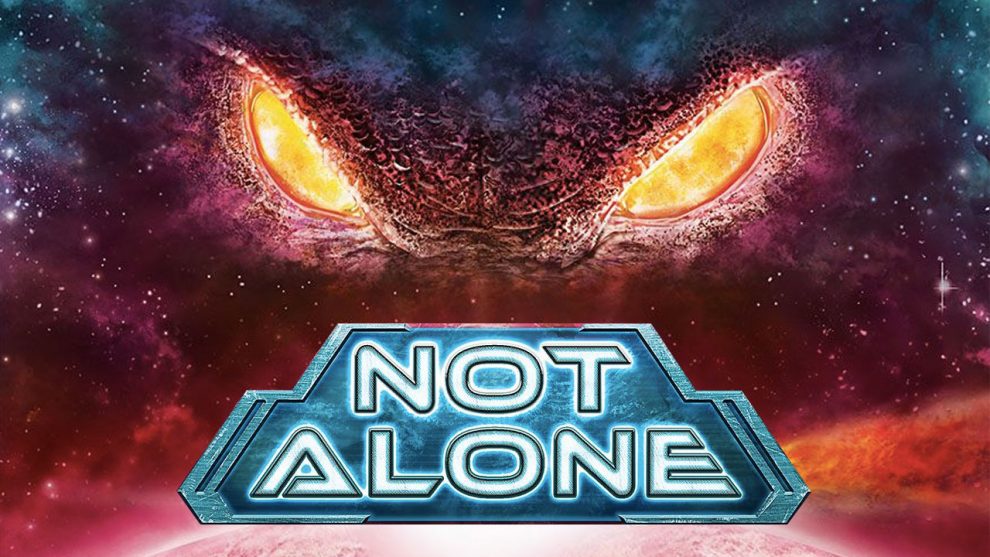The idea of one versus many is a concept expressed globally in many forms found in religion, movies, or culture. For some reason, humans love the idea of a group of underdogs going after one powerful entity. One merely has to look at Western movies to see characters like Predator, Jason Voorhees, and Freddy Krueger.
In the tabletop world, we’ve seen games like Fury of Dracula where a band of players tries to hunt down the Vampire player in a hidden movement scenario. When I heard several reviewers sing the praises of Not Alone, highlighting its easily digestible ruleset along with a 45-minute time frame, I had to investigate.
Like the start of any good science fiction story, a crew is marooned on a strange planet due to their ship making a very unexpected detour. Common sense kicks in, and they want to get off the planet as soon as possible by trying to signal a rescue ship. Being an alien planet that can sustain life, there is a hostile creature lurking in the wilderness hunting them that is controlled by a single player.
Preying On Your Friends
Besides its condensed yet engaging theme, one of the things I love about the presentation of Not Alone is the alien itself. Outside of glowing eyes, no piece of artwork shows the alien in full. While “hunting” incurs the idea of physically attacking the crew members, the alien in this game is trying to assimilate the crew members.
The three red cubes each crew member starts with aren’t “hit points” but Willpower. To put it bluntly, this alien is so proficient at stealth that not a single crew member knows what it looks like, and it attacks them in a way they cannot comprehend. Very few board games get their theme right, and Not Alone nails it here. Of course, the alien can only be in one place at a time.

The planet is represented by ten place cards labeled with the numbers 1-10. Each card is a point of interest for the crew to visit with a unique power that will help them. The core of the game is the crew members scrambling to these points of interest while the creature is trying to guess where they might be. Even though the crew members are on a team, they choose where they go as individuals. It is possible for the alien creature to catch only one crew member or several of them in one spot.
At first, this might sound overbearing, but the execution here is what makes this work. It’s one of the most accessible games I have ever taught, and this is solidified by player aid cards as well as all the cards having the rules written on them. Any board game that puts in the extra work to make it easier to teach new players deserves a slow handclap and a half.
Dealing With The Unknown
Speaking of rules, let’s get to it. The first phase of the game has the crew members pick a place card from their hand and put it face down simultaneously. Open table talk is allowed as long as the creature player can hear everything.
After the crew members hesitantly put down their place cards, the creature will place their tokens on spots they think the crew members will go. Most of the time, it’s going to be one token, but using Hunt cards will often allow several tokens to be placed. We’ll get to Hunt cards in a bit.
Once the creature is confident about its token placement, the crew members will reveal their chosen face down cards, and results will ensue. If a crew member is in a place with no tokens, they breathe a sigh of relief and get the use of the place’s power.
On the other hand, if there is a token, that place’s power is nullified, and the crew members caught will suffer a penalty such as a loss of Willpower or forced to discard an additional Place card. The card the crew members played to visit that space remains face-up in the discard pile for the creature to see.

Simple, right? It is an elaborate guessing game with the pacing of an Olympic swimmer carving through calm waters.
The first bit of observation of this greatness is the discard pile. As the players visit more places, their options dwindle, making it easier for the creature to track them down. The crew members can visit the “Lair” or “Jungle” to get those cards back, but if the creature catches them, it puts them into a more dire situation.
A somewhat safer way to get their cards is by spending their Willpower. Crew members spend their Willpower to get some of their cards back from the discard. Another option is to “give up” where a crew member will reset their Willpower back to 3 and get all of their cards back at the cost of the creature advancing one step towards their victory spot. If there is ever a situation where a crew member has no Willpower, they are forced to “give up” as well.
Besides the joy of hand management, the crew members need to evaluate the places they can visit. As mentioned before, each place has its own power. At the start of the game, the crew members only have the first 5 cards out of the 10 on the planet.
To get more cards, you need to visit the number 5 card Rover to get the 6 to 10 cards added to your hand. Is now a good time to do it? Maybe you can visit the River instead, allowing you to play two place cards next turn and pick one after the creature picked their spot. What if the creature is suspecting that type of play though? So many simple yet compelling choices like thumbing through a menu at a non-pretentious restaurant.

Rule Bending Cards
As if picking a place wasn’t hard enough, there are the Survival Cards and Hunt Cards. The Survival Cards are rule-breaking cards that mess with the creature, and each crew member has one at the start of the game. To get more cards, you need to visit the Shelter and Source places, which require you to get the Rover first. More incentives to make bad decisions.
The Hunt Cards are similar to Survival Cards, except it’s for the creature, and it will refill to 3 cards at the end of the round. It encourages the creature player to use them aggressively and, at its core, is designed to be a player-chosen rule breaker each round. Some of these can be nasty such as forcing all crew members to discard a Place card immediately or throwing in an extra token with a painful effect if anyone is caught by it. At first glance, it appears like a “take that” mechanism, but it doesn’t impact the importance of the two sides trying to outguess each other. Due to the random nature of these cards, it makes each game feel different even though the 10 places to visit will remain the same.
After almost a dozen plays, this is one of the most impressive fillers I have ever played. I’ve played with player counts as little as 3 up to a full crowd of 7. It is the typical ‘the more, the merrier’ type of deal, but I wouldn’t deny playing this game even at the lower player count since it still works quite well.
The reason for my impressions isn’t just the simplicity of the game or the alluring mind games at work; it’s the sandbox nature of the entire experience.

Crew members, while still a team, will make their own decision on how they want to approach the game. Maybe you’ll be the one who snatches the Rover just to grab the Wreck place card to expedite the rescue ship heading your way. Meanwhile, your friend Jasmine likes to abuse Survival cards so she takes the Shelter and the Source place cards after a few successful trips to the Rover. Bill decides to stick to the 5 starting place cards, visiting the Beach once in a while to grab the creature’s attention. It’s a co-operative game without the typical restraints of one.
Being the creature is fun as well. You are regularly appraising the discard piles of all the crew members and their behavioral quirks to try to read them out. The three hunt cards in your hand open up a buffet of possibilities for you to explore and exploit. Opportunities will arise, and you can make big plays that pounce the crew members or completely miss every single of them even though you have all three tokens in play. Like any good game, there is never an obvious answer to your problems here.
The best part about all of this is any gasps of victory or defeat are strictly decision-based. There is randomness in its card draws, yet the results of every single round are dependent on your choices. If you are caught by the creature, you were predictable, and missing all of the crew members as the creature implies you read the table completely wrong.
Not Alone’s objective is to provide a filler experience with a ‘one versus all’ aspect centered around guessing. Based on that goal, there isn’t anything faulty about its design. There are enough decisions to make this intriguing without overextending itself. One can argue to say the game might have limited replay value, but I would immediately point out that this is a “problem” with every filler game.
I wouldn’t play this religiously back to back, nor do I see the need to. To me, good game design is making a system of interesting choices under the guise of a simple rule set, and Not Alone is the physical embodiment of why I stick to that statement.
Buy Not Alone on Amazon US











Thanks for the review!
I keep meaning to try this on Board Game Arena – our group likes things like Saboteur.